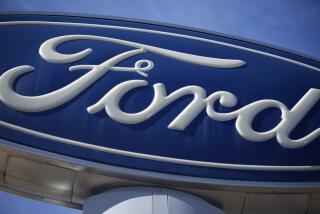Toyota restates hybrid goals
Those whoâve been wishing for more choices in hybrid gasoline-electric vehicles have been buzzing about word from Japan that Toyota Motor Corp. intends to have hybrid versions of all of its vehicle types available by 2012.
Wrong.
Dave Hermance, chief engineer in the environmental engineering section of Toyota Technical Center USA in Torrance, says what the company wants is to have a standardized hybrid system ready by 2012 to use in whichever segments it decides to offer a hybrid car or truck.
Quite a difference.
Hermance says language difficulties led to a misinterpreting of a Toyota engineering officialâs remarks to a reporter overseas, resulting in erroneous reports that the company was preparing to offer hybrid versions of everything it sells.
But thereâs still good news for hybrid fans.
Toyota Motor Sales America is expected to announce several new hybrids, possibly including a hybrid version of its small RAV-4 sport utility vehicle, at the North American International Auto Show in Detroit in January.
Hermance says the firmâs long-term plan is to make its hybrid system the universal standard, with a Toyota subsidiary producing the systems for sale to automakers across the globe.
Nissan Motor Co. already has agreed to purchase Toyota hybrid systems to add to a Nissan gasoline engine for a model to be sold in 2006.
Toyota President Fujio Cho previously has said the company intends to have more than 300,000 hybrids on the road worldwide by 2005. Toyota, which now makes the Prius hybrid, has sold more than 100,000 of the five-passenger compact sedans since its introduction in Japan in late 1998.
Hybrids combine two types of engines, typically a small gasoline or diesel internal combustion engine and an electric motor, to provide the power of a larger convention internal combustion engine with fewer emissions and more fuel economy.
Toyotaâs system uses the electric motor to augment a gasoline engine when additional power is needed for acceleration or hill-climbing, for example. The gasoline engine shuts down when the car stops, and the electric motor provides all the power at speeds up to about 20 mph.
A second type of system, used by Honda Motor Co. in its Insight two-seater and its five-seat Civic Hybrid model, also augments the gas engine with an electric motor but never runs in an all-electric mode.
Other automakers, including Ford Motor Co., DaimlerChrysler and General Motors Corp., also are developing hybrids and plan to begin offering models in the U.S. as early as 2004. Chrysler has shown one concept that uses electric motors to drive the front wheels and a gasoline engine to drive the rear wheels. Ford is developing an integrated starter motor that allows the gas engine to shut down at stops and immediately restart when the accelerator is depressed; the starter motor also would assist the gas engine during initial acceleration.
Toyotaâs strategy is to spread the cost of hybrid development across as broad a base of vehicles as possible and to work with partners, including Nissan, to make hybrid power plants a universally acceptable technology rather than the niche product they are seen as today. Doing so also would tend to make Toyotaâs system the industry standard.
Toyota and GM have been collaborating for the last three years on developing environmentally friendly automotive technologies, but Hermance says the work is concentrating on fuel-cell development and has not resulted in new hybrid technologies.
Hydrogen fueling station opens near San Francisco
The Sacramento-based California Fuel Cell Partnership has opened its first satellite hydrogen fueling station to provide fuel in the San Francisco area for hydrogen-powered fuel-cell electric vehicles being tested by the partnership members, including Ford, Hyundai, Toyota and DaimlerChrysler.
The station uses electricity and plain water to make hydrogen and was manufactured and installed at the AC Transit bus facility in Richmond last month by Stuart Energy of Ontario, Canada.
Both AC Transit and Stuart Energy are members of the fuel-cell partnership.
âThis is a key achievement for the partnership this year -- to be able to extend the test-drive range of our fuel-cell vehicles beyond the Sacramento area, and to learn about potential fueling infrastructure technologies through real-world experience,â said Don Huberts, the partnershipâs chairman and chief executive of Shell Hydrogen, a unit of Shell Oil Co.
The hydrogen station, about 70 miles from Sacramento, is capable of supplying the daily fueling needs of a small fleet of vehicles at a fueling rate of one to two minutes per vehicle.
Additional satellite stations for fuel-cell vehicles are planned by the partnership in the next few years throughout California. The fuel-cell partnership expects to place about 60 fuel-cell passenger cars and buses on the road by 2003.






